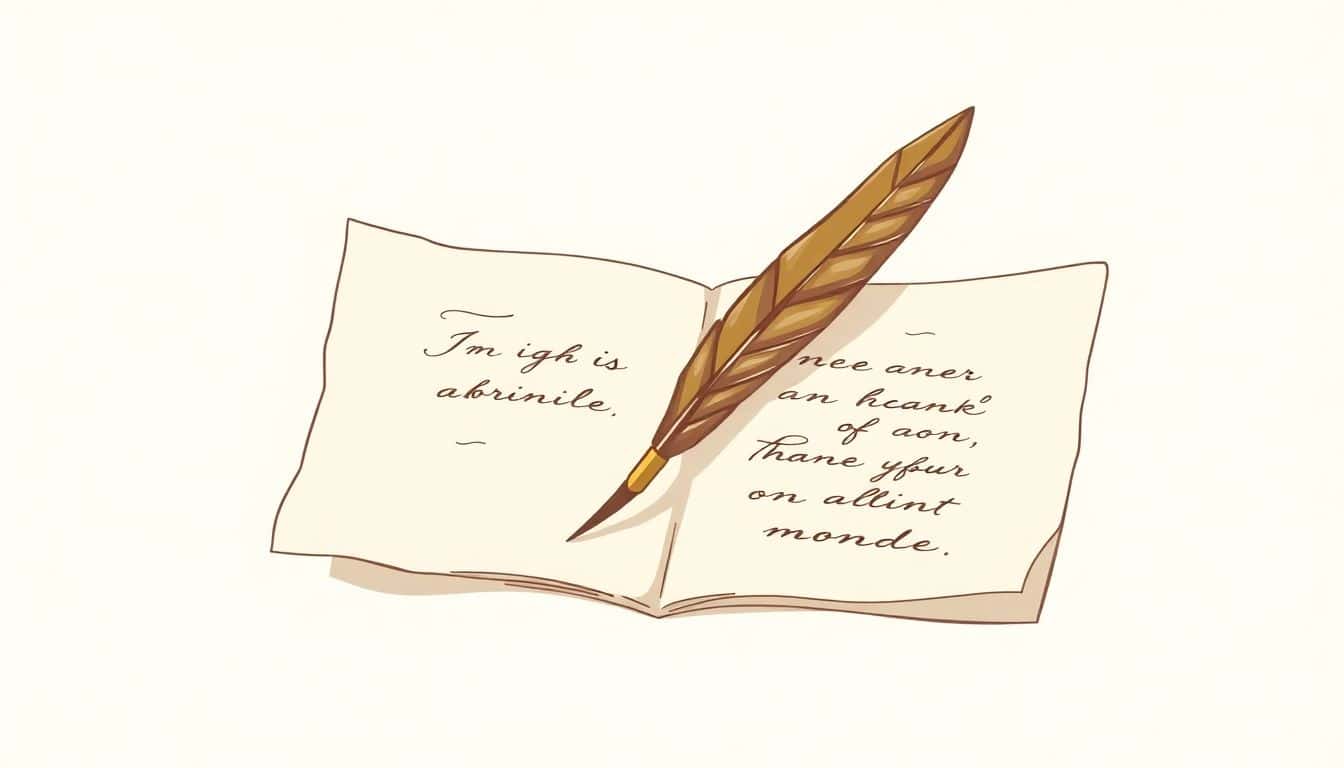Table of Contents
Writing historical dialogue can be tricky—you want it to sound real but also fit the style of the time. Sometimes, it’s hard to know if your characters’ words feel authentic or just modern scribbles with a fancy coat.
Stick with me, and I’ll show you simple ways to make your dialogue believable without sounding like a history book gone wrong. Keep reading, and you’ll learn tips to breathe life into your characters’ conversations so they feel right for the era you’re writing about.
Get ready for easy tricks and practical advice that will help your historical dialogue ring true—and maybe even make your stories more fun to write!
Key Takeaways
Key Takeaways
- Use primary sources like letters, diaries, and newspapers to learn how people spoke in the era you’re writing about. Don’t copy word for word, but capture the style and tone naturally.
- Understand the social and cultural background of your characters. A peasant and a noble from the same period will speak very differently, so tailor their speech accordingly.
- Keep dialogue clear and easy to understand. Use authentic vocabulary and phrases, but tweak complex or archaic language so it’s readable for modern readers.
- Study specific speech patterns and speech acts from the time period, such as how requests or commands were made, to add realism to interactions.
- Incorporate regional dialects carefully; subtle differences can add flavor without confusing readers. Research authentic pronunciation and idioms for accuracy.
- Compare multiple texts from the era to stay consistent in character voices and avoid modern language slipping in by mistake.
- Use language to show social status and power dynamics, like formal titles or casual speech, to make your characters’ roles clear and add depth.
- Balance authenticity with readability—avoid overly complex language that might turn off readers. Test dialogue snippets to ensure they feel natural and clear.

1. Do Thorough Research Using Primary Sources
The foundation of authentic historical dialogue is understanding how people spoke in a specific era. Primary sources like letters, diaries, newspapers, and official documents give you direct insight into vocabulary, idioms, and speech patterns of the time.
For instance, if you’re writing Victorian English, reading actual letters from that period can reveal how common folks and elites phrased their sentences. Websites such as author examples for students can help you see how real people expressed themselves.
Take notes on slang, formalities, and contractions they used, and try to incorporate these naturally into your dialogue. Remember, authentic dialogue doesn’t mean copying word for word but capturing the tone and style.
2. Understand the Social and Cultural Context
Language doesn’t exist in a vacuum—it’s shaped by social norms, class, occupation, and geography. Knowing who your characters are helps you craft believable speech. A peasant from medieval France will talk differently than a noble from the Renaissance.
Reading about social etiquette, politeness forms, and regional dialects can prevent modern stereotypes from sneaking into your writing. For example, studying 16th-century religious controversies or early Modern English medical dialogues can show you how experts and common folk differed in speech.
Scholarly works, like those published by John Benjamins Publishing, examine dialogue styles across different periods and languages. Use these to inform your choices and avoid anachronisms.
3. Balance Authenticity with Accessibility
While staying true to the historical period, your dialogue should still be understandable to modern readers. Intentionally archaic language can alienate or confuse if overdone. Aim for a sweet spot where the speech feels genuine but not cumbersome.
Start by using period-appropriate vocabulary and phrase structures, then tweak for clarity. For instance, replace overly complex expressions with simpler equivalents that still evoke the era. This way, your dialogue feels natural and engaging rather than awkward or stilted.
Remember, the goal is to transport your reader to another time without making them work too hard. If unsure, test dialogue snippets on friends or beta readers familiar with the period—they can tell you if it feels real or forced.

4. Study Specific Dialogue Patterns and Speech Acts in Different Periods
Different time periods had unique ways of expressing speech, and understanding these patterns can make your dialogue more believable.
For example, medieval French bargaining dialogues often used formal, ritualized phrases, while Early Modern English medical dialogues employed technical jargon with specific speech acts.
Studying how requests, commands, or apologies were made historically can help you write more accurate interactions—consider analyzing actual transcripts or texts from those eras.
Pay attention to how characters perform speech acts, like confirming or denying, and mirror their structures to make your dialogue sound period-appropriate.
Tools like the historical fiction ideas resource can guide you toward specific speech patterns relevant to your era, enhancing authenticity.
5. Incorporate Dialects and Regional Variations Carefully
Many historical characters spoke in distinct dialects or regional accents, which can add flavor and realism—if used thoughtfully.
Start by researching regional dialects of the period—French from Late Medieval Paris versus Southern rural dialects, for instance, sound very different.
Use subtle linguistic quirks rather than exaggerated spellings; for example, replacing “you all” with “y’all” can suggest Southern dialect, but don’t overdo it to avoid confusion.
Consult scholarly works or recordings if available, such as regional speech studies or recorded interviews, to get a better sense of authentic pronunciation and idioms.
Remember, the goal is to hint at regional origins without alienating your reader—think of it as seasoning rather than a full dialect immersion.
6. Analyze and Cross-Reference Multiple Texts for Consistency
When writing dialogue across multiple characters and scenes, cross-referencing sources ensures consistency in speech styles and language use.
Compare letters, transcripts, and literary works from your chosen period to see if characters maintain similar speech patterns or vocabulary choices.
Create a mini style sheet or glossary of specific phrases, idioms, and speech quirks for each character or social class to keep things uniform.
This method helps avoid accidental modernizations or anachronisms slipping into your dialogue as your story progresses.
Scholarly compilations, like the extensive studies published by John Benjamins Publishing, provide a treasure trove of dialogue examples that can serve as references.
7. Use Historical Dialogue as a Window into Social Hierarchies and Power Dynamics
Language often reflects social status—knights, peasants, and monarchs spoke very differently in the past.
By paying attention to how characters formalize or casualize their speech, you can subtly communicate their role and rank—think of the respectful titles used in 16th-century court dialogue.
Study how certain speech patterns serve as markers of authority or subservience, like the use of elaborate formalities or simple vernacular.
This adds depth, making the social fabric of your story feel more alive and accurate.
Reading about social etiquette in different periods, such as the works of Philip Carter or Elizabethan conduct manuals, can give you cues for this type of dialogue.
8. Be Sensible with Modern Readers’ Expectations and Ease of Understanding
While aiming for authenticity, keep in mind that overly obscure language can put off your readers.
Use period-appropriate vocabulary but avoid stuffing your dialogue with difficult words or lengthy sentences that might not have been realistic or accessible.
Test snippets of dialogue with beta readers familiar with the period or era—if they struggle, simplify slightly without losing authenticity.
Remember, the overall goal is to make your story feel immersed in its time while still being accessible for modern audiences.
Sometimes, small adjustments—like replacing Latin terms with their English equivalents or simplifying convoluted syntax—can make a big difference.
FAQs
Focus on language, slang, and speech patterns typical of the era. Study authentic writings and speeches from that time to replicate vocabulary and expressions that feel natural to the period.
Use context-specific vocabulary and avoid modern slang. Consider characters’ social status and background, and listen to how people spoke differently across regions and classes.
Balance accurate language with natural speech. Use period-appropriate expressions sparingly and focus on making dialogue lively and relatable, avoiding overly formal or archaic phrases.



